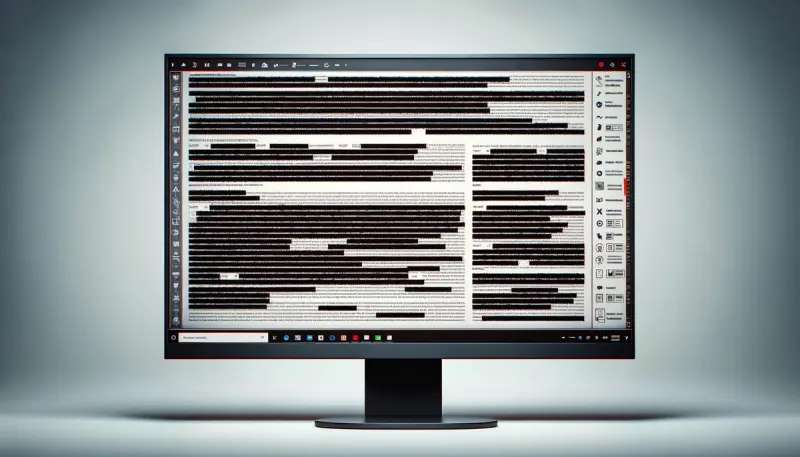Digital Document Security in Public Sectors | Document Redaction Explained
By Riley Kooh | 2023 Dec 13

5 min
Tags
redaction
security
document processing
Summary
Technology is rapidly transforming every aspect of our lives, and the public sector is no exception. With discussions looming of governments around the world shifting towards an all-digital structure, streamlining these digital processes while ensuring accessibility and security is essential. While the benefits of this digital transformation are undeniable, it brings along a set of challenges, especially at the scale of nation-wide governments and public institutions. In this blog post, we'll delve into the world of digital document security in public sectors, with a specific focus on document redaction – a crucial component in safeguarding sensitive information.
The Allure of an All-Digital Government
The move towards a fully digital government is driven by a desire for efficiency, cost-effectiveness, and improved public services. Digital document management systems promise faster access to information, reduced paperwork, and streamlined workflows. Citizens can submit applications, access services, and communicate with government agencies seamlessly through online platforms.
Key Benefits at a Glance:
Enhanced Citizen Convenience and Engagement
- Quick and easy access to services.
- Fostered civic engagement and increased community participation.
Internal Efficiency and Collaboration
- Improved productivity, allowing staff to focus on essential tasks.
- Enhanced collaboration between government departments.
Cost Reduction and Environmental Impact
- Reduced labor costs and paper usage.
- Efficient resource utilization for better service delivery.
Transparency and Improved Relations
- Increased transparency in government operations.
- Improved relationship between government and citizens.
Adaptability and Security
- Agility to meet changing citizen needs.
- Implementation of secure digital platforms for data protection.
The Risks of Going Digital

However, the transition to an all-digital government also poses significant security risks. As information becomes more accessible, the potential for unauthorized access, data breaches, and leaks increases. Since the year 2000, just the top 15 data breaches account for over 10 billion hacked files, including credit card info, login data, and other personal records. As we shift to housing everything online, sensitive documents, such as legal records, financial statements, and personal information, are all vulnerable to exploitation. So, what steps can government agencies put in place to ensure that our files are safe?
Governing Agencies and Document Security
To mitigate these risks, several governing agencies play a crucial role in establishing and enforcing document security standards. These agencies set guidelines, conduct audits, and implement measures to safeguard sensitive information. Examples include the National Institute of Standards and Technology (NIST) in the United States and the Information Commissioner's Office (ICO) in the United Kingdom to name a few. Compliance with these standards is essential for government agencies to ensure the highest level of security in their digital document management systems.
Document Redaction: A Key Element in Digital Security

One essential tool in the government's arsenal to protect sensitive information is document redaction. Redaction involves the careful editing or obscuring of specific information within a document, ensuring that only authorized individuals have access to certain details. While traditional redaction methods involved manually blacking out or covering sensitive information with markers, the digital age brings advanced techniques that are more accurate, efficient, and secure.
The Role of Document SDKs in Enhancing Security
Document redaction has evolved significantly with the introduction of dedicated workflows incorporating Document Software Development Kits (SDKs). These SDKs provide a set of tools and functionalities that developers can integrate into their applications to enhance document security. In the context of government document management, a Document SDK can be a game-changer.
1. Accuracy and Precision
Document SDKs utilize advanced algorithms to precisely identify and redact sensitive information. Unlike manual methods, which can be prone to errors and oversights, an SDK allows enables users to ensure a high level of accuracy. This is crucial in scenarios where even the slightest oversight in redaction could lead to domino effect of data leakage.
2. Efficiency in Bulk Processing
Government agencies deal with an immense volume of documents daily. Manual redaction of each document is not only time-consuming but also prone to delays. Document SDKs enable efficient bulk processing, allowing a user to redact multiple documents simultaneously. This not only saves time but also ensures that sensitive information is promptly secured.
3. Audit Trails and Accountability
Document SDKs often come equipped with features that create detailed audit trails. These trails track every action taken during the redaction process, providing an accountability mechanism. In the event of an audit or security breach, agencies can trace who accessed, edited, or redacted specific information. This transparency is vital for maintaining trust and complying with security standards.
4. Integration with Existing Systems
A Document SDK can seamlessly integrate with existing document management systems and workflows. This integration ensures a smooth transition to enhanced security measures without disrupting day-to-day operations. Government agencies can leverage their current infrastructure while benefitting from the added layer of security provided by the Document SDK.
5. Reducing Human Error
Automated redaction through Document SDKs minimizes the reliance on manual intervention, thereby reducing the risk of human error. The consistency and precision achieved through automation contribute significantly to the overall security of government documents.
Want to learn more? Check out our complete guide to redaction with Apryse SDKs.
Challenges and Considerations
While Document SDKs offer a robust solution for document redaction, it's essential to acknowledge potential challenges. The implementation of such technologies requires careful consideration of privacy laws, user training, and ongoing updates to stay ahead of emerging threats. Moreover, the effectiveness of these tools depends on the commitment of government agencies to adhere to security protocols and invest in regular training for personnel.
Where Apryse Fits the Bill
The main challenge of any effective tool is the adoption of it. If the barrier of entry is too high, even a highly useful tool may be left at the wayside due to its extended learning curve. That’s why at Apryse, we offer a variety of solutions to develop in any space (web, mobile, or server side), language, and framework. With high-code, low-code, and no-code options available, finding an intuitive, customizable, and secure document management tool has never been easier.
Click here to check out our product showcase or here to kick off a free trial to start experimenting in your own projects.
Questions? Don’t hesitate to reach out here to get in touch with one of our team members.
Tags
redaction
security
document processing

Riley Kooh
Share this post


